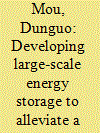| Srl | Item |
| 1 |
ID:
166934


|
|
|
|
|
| Summary/Abstract |
By taking the grid system in Fujian Province as an example, this paper establishes a power market system model to simulate the impact of nuclear and wind power on the system operation. The article employs the method of optimal power flow (OPF) analysis, under a framework of social welfare maximization with close-to-reality thermal power generation cost and technical constraints. The simulation results show that large-scale nuclear power can reduce the level of electricity prices and improve the difference in regional electricity prices; as a result, the thermal power can be in an unfavourable position and therefore undertake peak and load following; meanwhile, the development of large-scale wind power would increase the demand for following of load and valley load. Moreover, the simulation for the operation of the electricity market shows that in the case of electricity oversupply, the thermal power can be deliberately bid at a low price, and the nuclear power would assume the obligation of valley load following, even with the presence of PSHPs in the system; thus, the low-carbon energy can't be fully utilized. In conclusion, the general bidding model in the electricity market cannot be applied to the situation of long-term electricity oversupply.
|
|
|
|
|
|
|
|
|
|
|
|
|
|
|
|
| 2 |
ID:
169856


|
|
|
|
|
| Summary/Abstract |
the literature proposes that a booming minerals sector leads to a development curse. The mineral markets in China experienced a prolonged boom over the period of 2000–2010. We empirically examine the effects of mineral resources on employment in county economies during the boom. We consider the endogeneity of the resource measure and employ an instrumental variables approach to resolve the problem. We find the mining boom exerts a significant “crowding out” effect on the manufacturing employment in mineral-resource-dependent counties, but benefits the employment in services. Because the increase in mining employment is sizeable in a mining boom, the overall employment in the resource-dependent counties has shown a small growth. These results are robust to alternative samples. Our findings confirm the argument that resource booms undermine manufacturing sectors through deindustrialization effects, though little evidence shows the existence of a resource curse in overall employment. We conclude that for a developing economy with rich mineral resources and a large population, it would be hard to following the road of industrialization relying on manufacturing.
|
|
|
|
|
|
|
|
|
|
|
|
|
|
|
|
| 3 |
ID:
115135


|
|
|
|
|
| Publication |
2012.
|
| Summary/Abstract |
The characteristics of China's energy structure and the distribution of its coal resources make coal transportation a very important component of the energy system; moreover, coal transportation acts as a bottleneck for the Chinese economy. To insure the security of the coal supply, China has begun to build regional strategic coal reserves at some locations, but transportation is still the fundamental way to guaranty supply security. Here, we study China's coal transportation quantitatively with a linear programming method that analyses the direction and volume of China's coal flows with the prerequisite that each province's supply and demand balance is guaranteed. First, we analyse the optimal coal transportation for the status quo coal supply and demand given the bottleneck effects that the Daqin Railway has on China's coal flow; second, we analyse the influence of future shifts in the coal supply zone in the future, finding that China's coal flows will also change, which will pressure China to construct railways and ports; and finally, we analyse the possibility of exploiting Yangtze River capacity for coal transportation. We conclude the paper with suggestions for enhancing China's coal transportation security.
|
|
|
|
|
|
|
|
|
|
|
|
|
|
|
|